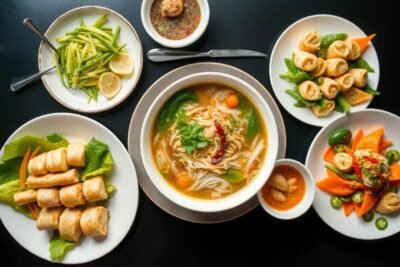
Delicious and Diabetes-Friendly Chinese Food Options
- Introduction to Diabetes-Friendly Chinese Cuisine
- Understanding Carbohydrates and Glycemic Index
- Healthy Cooking Techniques in Chinese Cuisine
- Low-Carb Chinese Food Ingredients to Include
- Diabetes-Friendly Chinese Dishes to Try
- Tips for Ordering Chinese Food When Dining Out
- Meal Prep Ideas for a Diabetes-Friendly Week
- Popular Myths About Chinese Food and Diabetes
- Conclusion: Embracing Flavor with Health in Mind
Introduction to Diabetes-Friendly Chinese Cuisine
Chinese cuisine is celebrated for its wide array of flavors, textures, and ingredients. However, for individuals managing diabetes, it is essential to make informed food choices that align with their health needs. Diabetes-friendly Chinese food can offer a delicious balance of taste and nutritional value, allowing individuals to enjoy the culinary riches of this cuisine without jeopardizing their health. The selection of ingredients and cooking techniques plays a crucial role in crafting meals that are suitable for those with diabetes.
One key aspect is the emphasis on fresh vegetables, lean proteins, and whole grains, which are commonly found in traditional Chinese dishes. These components not only contribute to a balanced diet but also help regulate blood sugar levels. Ingredients such as tofu, chicken, and fish are great sources of protein that can be enjoyed in moderation. Furthermore, using brown rice instead of white rice can provide essential fiber, which aids in maintaining stable glucose levels and supports digestive health.
Moreover, flavoring is another significant component of diabetes-friendly Chinese cuisine. Herbs and spices such as ginger, garlic, and chili can enhance the taste of dishes while offering potential health benefits. They can help improve insulin sensitivity, which is particularly beneficial for those managing diabetes. Additionally, opting for steaming, stir-frying with minimal oil, or braising instead of deep-frying ensures that meals retain their nutritional value without excess calories, thereby making them more diabetes-friendly.
In essence, the concept of diabetes-friendly Chinese food signifies that individuals with diabetes do not have to sacrifice flavor or variety in their meals. With mindful preparation and ingredient selection, it is completely possible to savor the delectable tastes of Chinese cuisine while actively managing one's health. This approach not only makes dining enjoyable but also supports overall health and well-being.
Understanding Carbohydrates and Glycemic Index
Carbohydrates are one of the three main macronutrients that provide energy to the body, with the other two being proteins and fats. Foods rich in carbohydrates can be broadly classified into two categories: simple carbohydrates and complex carbohydrates. Simple carbohydrates are quickly digested and can lead to rapid spikes in blood sugar levels, whereas complex carbohydrates are digested more slowly, providing a more gradual release of glucose into the bloodstream. For individuals managing diabetes, it is essential to understand how these carbohydrates impact overall blood sugar control.
The glycemic index (GI) is a ranking system that measures how quickly carbohydrates in food affect blood sugar levels compared to pure glucose. Foods that have a high GI are rapidly digested and cause a swift increase in blood sugar, which can be detrimental for people with diabetes. Conversely, low-GI foods are digested at a slower rate, resulting in a more gradual rise in blood glucose levels. For those seeking diabetes-friendly Chinese food options, focusing on low-GI dishes is critical, as they help maintain stable blood sugar levels throughout the day.
In general, low-GI foods tend to be higher in fiber and nutrients, which contributes positively to overall health. When selecting Chinese food that is appropriate for diabetes management, it is advisable to opt for whole grains such as brown rice or quinoa, and to include plenty of vegetables. Dishes that incorporate lean proteins and healthy fats, while minimizing sugary sauces and fried items, can make for a diabetes-friendly meal. Understanding the relationship between carbohydrates and the glycemic index empowers individuals with diabetes to make informed dietary choices, ultimately promoting better health outcomes and enhancing their quality of life.
Healthy Cooking Techniques in Chinese Cuisine
Chinese cuisine is renowned not only for its rich flavors but also for its variety of cooking techniques that emphasize health. For individuals managing diabetes, selecting appropriate cooking methods can significantly impact meal preparation and overall health. Among the most popular techniques are steaming and stir-frying, both of which can result in delicious dishes while adhering to a diabetes-friendly diet.
Steaming is a traditional method in Chinese cooking that preserves the natural flavors and nutrients of ingredients. By using steam to cook vegetables, fish, and even poultry, this technique allows meals to maintain their texture and essential vitamins. For example, steamed dumplings made from whole wheat flour and filled with lean protein and vegetables can be an excellent choice for those looking to enjoy diabetes-friendly Chinese food. This method requires little or no added fat, making it ideal for individuals seeking to manage their carbohydrate intake alongside other health considerations.
Another effective technique is stir-frying, which, when executed properly, can also contribute to healthier meals. It involves cooking ingredients quickly over high heat with minimal oil, often using a non-stick pan or wok. By focusing on fresh vegetables, lean meats, and low-sodium sauces, individuals can create flavorful dishes that are beneficial for managing diabetes. Utilizing oils such as olive or canola oil in the right amounts can also add healthy fats without overwhelming the meal with calories. Additionally, incorporating more vegetables and limiting the use of starches like rice or noodles can enhance the nutritional profile of any dish.
In conclusion, by utilizing traditional Chinese cooking techniques such as steaming and stir-frying, individuals can enjoy a range of diabetes-friendly Chinese food options. These methods emphasize fresh ingredients and health-conscious preparation, promoting both flavor and well-being in meals.
Low-Carb Chinese Food Ingredients to Include
A crucial aspect of managing diabetes while enjoying Chinese cuisine is to focus on low-carb ingredients that not only taste great but also provide nutritional benefits. Various vegetables, lean proteins, and herbs can be incorporated into meals to create diabetes-friendly Chinese food options. These ingredients, when prepared thoughtfully, help maintain blood sugar levels without compromising on flavor.
One of the best low-carb ingredients to include is leafy greens, such as bok choy, spinach, and Chinese broccoli. These vegetables are rich in fiber and essential vitamins while being low in carbohydrates. Additionally, mushrooms, such as shiitake and enoki, add a savory umami flavor without the carb count, making them an excellent choice for stir-fries and soups.
In terms of proteins, lean meats like chicken, turkey, and seafood present wonderful options. Skinless chicken breast, for example, can be stir-fried with a range of vegetables for a delicious dish that satisfies dietary needs while remaining diabetes-friendly. Tofu is another versatile, low-carb source of protein that works well in soups, stews, and stir-fried dishes, absorbing the flavors of garlic and ginger beautifully.
Herbs and spices also play a significant role in enhancing the taste of Chinese dishes without adding carbohydrates. Incorporating garlic, ginger, and green onions can elevate a dish, providing rich flavors without relying on high-carb ingredients. Additionally, incorporating sauces such as low-sodium soy sauce or tamari provides a savory depth without unnecessary sugars. By focusing on these ingredients, anyone can create a variety of delightful, diabetes-friendly Chinese food that caters to their health requirements while enjoying a flavorful culinary experience.
Diabetes-Friendly Chinese Dishes to Try
When it comes to navigating the world of Chinese cuisine while managing diabetes, it is important to choose dishes that are low in sugar and refined carbohydrates while being rich in nutrients. Below is a curated list of diabetes-friendly Chinese dishes that not only satisfy the palate but also contribute to better health management.
One popular option is steamed fish, often prepared with ginger, garlic, and scallions. This dish is packed with omega-3 fatty acids, which can help improve heart health. The steaming process avoids the need for excessive oils, making it a good choice for those with diabetes. Additionally, the use of herbs and spices instead of sugary sauces ensures that the flavor remains rich without compromising blood sugar levels.
Vegetable stir-fries are another excellent choice, as they can be tailored to include a variety of non-starchy vegetables, such as broccoli, bell peppers, and bok choy. These dishes can be prepared with low-sodium soy sauce or a splash of rice vinegar to enhance flavor without adding unnecessary sugars. By incorporating lean proteins such as tofu or chicken, you create a balanced meal that is high in fiber and low in unhealthy fats.
Additionally, consider hot and sour soup, which is generally lower in calories and carbohydrates. It combines a variety of vegetables and can be thickened using low-calorie ingredients. The soup's combination of sour flavors from vinegar and spiciness from pepper gives it a satisfying taste while remaining diabetes-friendly.
Each of these dishes can be further modified to increase their health benefits. For instance, opting for brown rice over white rice in a stir-fry can enhance fiber content, aiding in blood sugar control. By choosing wisely, you can enjoy a range of diabetes-friendly Chinese food options that are flavorful and nutritious.
Tips for Ordering Chinese Food When Dining Out
When dining out and craving Chinese food, making diabetes-friendly choices is essential to manage your health. To begin with, consider reviewing the menu thoroughly before making your selection. Look for dishes that are steamed, grilled, or stir-fried with minimal oil. These cooking methods often lower the fat content, making them better choices for a diabetes-friendly meal. Popular dishes such as steamed vegetables or stir-fried proteins without heavy sauces can be excellent options.
Another effective strategy is to prioritize dishes that feature lean proteins and plenty of vegetables. Options like chicken with broccoli or beef with mixed vegetables provide both nutrients and fiber, which can aid in managing blood sugar levels. It is also advisable to avoid fried items such as spring rolls or crispy noodles, which can lead to higher glycemic responses due to added oils and carbohydrates.
Portion control is critical when enjoying Chinese food. Many restaurants serve oversized portions, so consider sharing a dish or asking for a smaller option if available. Additionally, you can request to have half of your meal packaged to take home before you begin eating. This practice will help prevent overeating, as it becomes easier to consume what's in front of you rather than stopping when you are satisfied.
Lastly, sauces can often include hidden sugars and additional calories that may not align with your dietary needs. To maintain control over your sugar intake, request sauces on the side. This allows you to enjoy the flavors without dousing your food, ensuring that the dish remains diabetes-friendly. For further flavor enhancement and to reduce overall sugar consumption, consider using low-sodium soy sauce or vinegar dip instead of high-sugar options.
Meal Prep Ideas for a Diabetes-Friendly Week
Effective meal planning is essential for anyone managing diabetes, as it helps maintain balanced blood sugar levels while enjoying a variety of flavorful foods. Within the realm of Chinese cuisine, there are numerous opportunities to create dishes that are not only satisfying but also diabetes-friendly. Here are some creative meal prep ideas that can sustain you throughout the week.
First, consider preparing a large batch of stir-fried vegetables, such as bok choy, bell peppers, and broccoli, tossed in a light soy sauce or ginger-infused broth. These vegetables are low in carbohydrates and high in fiber, making them suitable for a diabetes-friendly diet. Pair them with brown rice or quinoa instead of white rice to boost the nutritional profile while keeping blood sugar levels stable.
Another excellent option is to prepare a low-sodium chicken or tofu stir-fry. Using lean protein and a variety of fresh vegetables can provide a nutritious and satisfying meal. You can marinate the chicken or tofu in a blend of garlic, scallions, and a splash of rice vinegar to infuse flavor without adding excessive sugar. Portion these stir-fries into meal containers, and pair them with a serving of whole grains for easy access throughout the week.
Soup is a staple in Chinese cuisine that can be easily adapted for a diabetes-friendly diet. Prepare a low-sodium vegetable or chicken broth as your base and then add in ingredients such as tofu, leafy greens, and mushrooms. This hearty soup can be frozen in individual portions, providing a convenient meal option that is both filling and healthy.
Moreover, incorporating a salad made from ingredients like shredded cabbage, carrots, and edamame can also be beneficial. Dress it with a simple sesame oil vinaigrette to elevate the flavor. By integrating these meal prep ideas into your week, not only will you simplify your cooking routine, but you will also ensure that you are making nutritious choices that align with managing diabetes, all while enjoying delicious Chinese food.
Popular Myths About Chinese Food and Diabetes
Chinese cuisine is often misconceived as being inherently unhealthy, particularly for individuals managing diabetes. This perception stems from the association of traditional dishes with high carbohydrate content, excessive sugar, and unhealthy fats. However, it is crucial to address these myths, as many Chinese food options can be diabetes-friendly when prepared and consumed mindfully.
One prevalent myth is that all Chinese food is fried and loaded with grease. While it is true that some dishes involve deep-frying, numerous options are prepared through steaming, stir-frying, or braising. Steamed vegetables, for instance, are a staple in many Chinese meals and provide essential nutrients without adding excess calories or carbohydrates. Additionally, selecting dishes that emphasize lean proteins, such as chicken, tofu, or fish, can enhance nutritional value while keeping meals diabetes-friendly.
Another common misconception is that Chinese food always contains high levels of sugar due to the use of sauces. However, many sauces can be modified or substituted to reduce their sugar content. Opting for dishes that utilize low-sugar sauces or asking for sauce on the side allows individuals to control their intake. A well-balanced plate of diabetes-friendly Chinese food may include a variety of vegetables, protein sources, and whole grains, such as brown rice, which provides fiber and aids in managing blood sugar levels.
Moreover, the notion that Chinese food cannot fit into a healthy lifestyle for those with diabetes overlooks the cultural diversity within Chinese cuisine itself. Regions in China offer different specialties that can cater to various dietary needs. By understanding the components of a meal and making informed choices, individuals can enjoy delicious and satisfying Chinese meals without compromising their health. It is essential to approach Chinese food with an open mind, recognizing that when prepared thoughtfully, it can be both flavorful and supportive of diabetes management.
Conclusion: Embracing Flavor with Health in Mind
Chinese cuisine is renowned for its vibrant flavors, diverse ingredients, and culinary techniques that can be tailored to accommodate various dietary needs, including those of individuals managing diabetes. By exploring diabetes-friendly Chinese food options, one can enjoy a rich and varied menu without compromising health. Integrating whole, nutritious ingredients and balancing flavors are essential components that can be emphasized in traditional and contemporary dishes alike.
For those with diabetes, it is critical to make informed choices when it comes to selecting Chinese dishes. Opting for meals that emphasize vegetables, whole grains, lean proteins, and healthy fats can help maintain stable blood sugar levels. Instead of deep-fried options or overly sweet sauces, consider steamed, stir-fried, or roasted dishes that highlight fresh produce and wholesome ingredients. By being conscious of portion sizes and ingredient selections, individuals can indulge in the tasty offerings of Chinese cuisine while adhering to their dietary requirements.
The beauty of Chinese food lies in its versatility. Many traditional recipes can be easily modified to make them more diabetes-friendly without sacrificing taste. For example, using low-sodium soy sauce, reducing sugar content, and incorporating legumes can result in healthier, satisfying meals. Moreover, recipes that include a variety of colors not only create visual appeal but also provide a broad spectrum of nutrients essential for overall health.
Ultimately, it is possible to enjoy a wide range of delicious Chinese dishes while remaining committed to effective diabetes management. By embracing the flavors of this rich culinary tradition mindfully, one can nourish the body while savoring every bite. Engaging with the diverse offerings available in Chinese cuisine ensures that health and enjoyment can harmoniously coexist on the dining table.










